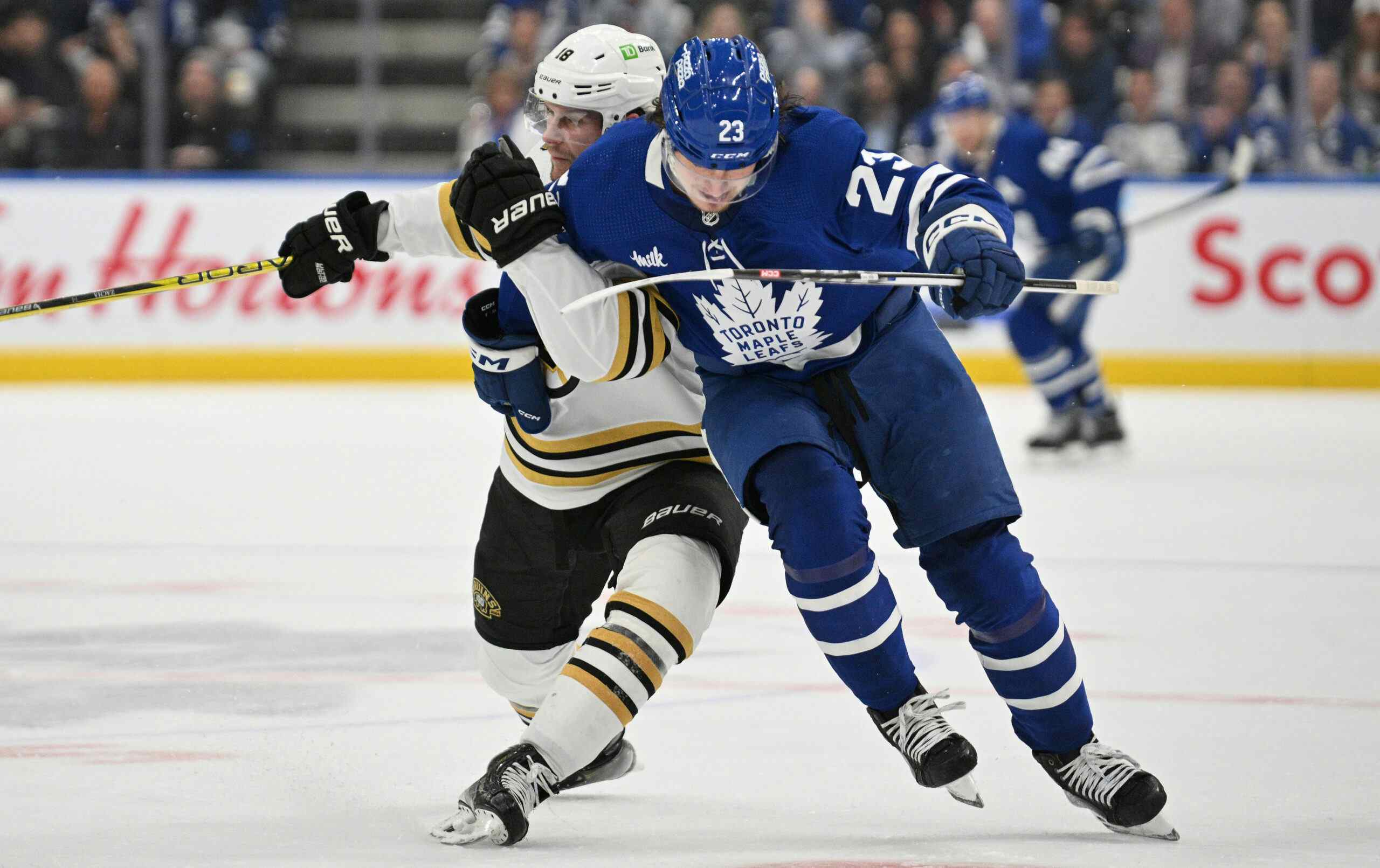Paying For Schenn’s Minutes

Prior to the announcement that the Maple Leafs had signed Luke Schenn to a five year/$18.0 million contract, this site ran a post titled “What’s Luke Schenn Worth?” That post looked at a given set of comparable players to Schenn – defensive defensemen with roughly the same age, minutes played, and NHL experience as Schenn.
I’d like to do something similar here, but use different criteria to find comparable players.
As the title alludes, my search isn’t for players with a comparable career trajectory to Schenn, but rather to find out what it would cost the Maple Leafs to bring in a player that handles roughly the same role as Schenn does now. Obviously, this doesn’t take into account Schenn’s potential for future growth, but it should give us an idea of what kind of premium the Leafs’ are paying for that potential.
Using NHL.com, I grabbed a list of 15 players that saw comparable ice-time to Schenn.
The Comparables
| Player | EVTOI/GM | SHTOI/GM | PPTOI/GM |
|---|---|---|---|
| Luke Schenn | 18.63 | 2.73 | 0.98 |
| Francois Beauchemin | 18.58 | 2.80 | 1.65 |
| Dan Hamhuis | 17.95 | 3.15 | 1.57 |
| Henrik Tallinder | 19.62 | 2.35 | 0.55 |
| Kevin Bieksa | 18.07 | 2.66 | 1.72 |
| Zach Bogosian | 18.40 | 2.02 | 1.97 |
| Andy Greene | 18.75 | 2.32 | 1.27 |
| Jason Garrison | 17.58 | 3.13 | 1.55 |
| Toni Lydman | 17.83 | 3.72 | 0.60 |
| Eric Brewer | 18.30 | 3.12 | 0.58 |
| Zbynek Michalek | 16.86 | 3.77 | 1.18 |
| Adrian Aucoin | 17.78 | 2.98 | 0.87 |
| Brad Stuart | 17.40 | 3.53 | 0.57 |
| Derek Morris | 17.73 | 2.52 | 0.78 |
| Victor Hedman | 17.32 | 2.03 | 1.63 |
| Tim Gleason | 17.22 | 2.72 | 1.00 |
All numbers are from last season, and I’ve included ice-time at even-strength, while short-handed and on the power play.
Still, while all these players took on similar minutes, the question remains whether or not they performed similarly in their roles, so our next task is to eliminate players that performed differently than Schenn.
Offense
While it’s true that Schenn averaged just under a minute on the power play last season, his offensive contribution was more than negligible – it was non-existent. In fact, in three seasons in the NHL, Schenn has recorded just a single power play point – a goal in his rookie season. Logically, then, we can eliminate from consideration any player that makes a non-trivial contribution to his team’s power play.
On that basis, we can eliminate Dan Hamhuis, Kevin Bieksa, Zach Bogosian and Andy Greene from the conversation. All have played well on the power play for at least one full season in the last two, and all can reasonably be expected to provide more offense in those situations than Schenn. Others on this list – players like Beauchemin, Aucoin, Stuart and Morris – have filled the role in the past but not recently, so they remain under consideration.
At even-strength, Luke Schenn posted 0.85 points for every 60 minutes of ice-time last season, and 0.90 points/60 the year before that, so we can consider those numbers his range at 5-on-5. They’re very strong numbers – in around the 1.00 points/60 range is the upper limit for a strong point-producing defenseman at even-strength, so we’re looking for something of a conundrum in our comparables: good at even-strength scoring, but bad or unutilized on the power play.
| Player | EVTOI/GM | 5v5 Scoring |
|---|---|---|
| Victor Hedman | 17.32 | 1.07* |
| Brad Stuart | 17.40 | 0.91 |
| Adrian Aucoin | 17.78 | 0.88 |
| Toni Lydman | 17.83 | 0.86 |
| Luke Schenn | 18.63 | 0.85 |
| Zbynek Michalek | 16.86 | 0.76* |
| Eric Brewer | 18.30 | 0.72 |
| Jason Garrison | 17.58 | 0.63* |
| Francois Beauchemin | 18.58 | 0.58 |
| Derek Morris | 17.73 | 0.55 |
| Tim Gleason | 17.22 | 0.53 |
| Henrik Tallinder | 19.62 | 0.46 |
The players in the same range as Schenn last season include Stuart, Aucoin, and Lydman. Victor Hedman was a high-end producer at even-strength, but I’ve opted to keep him in the discussion because his even-strength points/60 numbers a year ago compare well to Schenn’s (0.91 for Hedman vs. 0.90 for Schenn). Similarly, Michalek and Garrison had weaker years by this measure, but in the past their numbers have been close to Schenn’s. The other five players (Brewer, Beauchemin, Morris, Gleason and Tallinder) have had significantly poorer recent results than Schenn in this area and are thus removed from consideration.
Context and Defense
Obviously, though, offense is just one part – and for a defensive rear guard, a comparatively small part – of a player’s game. To give us an idea of the hard to quantify defensive ability of our remaining players, I’m going to use three measures.
- QualComp Rk. – This number indicates where a player ranks among his team’s regular defensemen in terms of Quality of Competition, a metric created by Gabriel Desjardins that uses the NHL’s play-by-play sheets to measure the quality of the opponents that a player regularly takes to the ice against. It’s found at behindthenet.ca.
- ZoneStart – Another behindthenet.ca statistic, this one tracks what percentage of a player’s shifts started in the offensive or defensive zone. A number greater than 50.0% indicates more offensive starts, a smaller number more defensive starts.
- Rel. Corsi – Also found at Behind the Net, Corsi is essentially a count of shot attempts for and against while a player is on the ice, while the relative designation indicates that it is adjusted for team strength. This number has to be taken into context – a player can have a great Corsi but still be performing badly, especially if he’s playing lousy opponents and starting a lot in the offensive zone – but it typically compares very closely to scoring chances.
| Player | EVTOI/GM | QualComp Rk. | Zone Start | Rel. Corsi |
|---|---|---|---|---|
| Toni Lydman | 17.83 | First | 42.9 | 9.2 |
| Victor Hedman | 17.32 | Fourth | 50.0 | 8.4 |
| Luke Schenn | 18.63 | Fourth | 49.3 | 1.5 |
| Jason Garrison | 17.58 | First | 42.2 | -0.8 |
| Adrian Aucoin | 17.78 | Third | 46.0 | -1.5 |
| Zbynek Michalek | 16.86 | Fourth | 48.7 | -2.6 |
| Brad Stuart | 17.40 | Second | 46.9 | -13.4 |
Lydman and Garrison both played highly difficult minutes last season – much more difficult than Schenn’s – so we can eliminate them from consideration. We can also eliminate Stuart, a typically strong defenseman who clearly had a poor year in Detroit. That leaves three players who put in a comparable season to Schenn:
- Victor Hedman, Tampa Bay – $3.5 million cap hit (still on entry-level deal)
- Zbynek Michalek, Pittsburgh – $4.0 million cap hit
- Adrian Aucoin, Phoenix – $2.0 million cap hit
Even allowing for the fact that Michalek had a somewhat disappointing season in Pittsburgh after years as a shutdown man in Phoenix, I think we could argue the $3.0 million level as an appropriate one for defensemen like Schenn (top-four minutes, decent results, strong even-strength offense and negligible power play offense). Given the potential for improvement, the Leafs’ decision to pay $3.6 million per season seems sound – it will likely represent a slight premium early on, but over the long haul should equate to decent value.
Recent articles from Jonathan Willis





